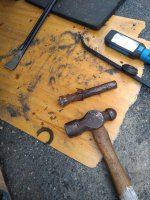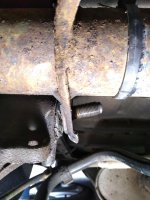- Joined
- Jun 12, 2009
- Messages
- 716
- Points
- 164
And some threaded bar and an array of washers to press in the new races. The old races can be used to press in the new ones if they are not too destroyed.
Marty.
Marty.







Great photos Oletimer. Thanks for taking the time to take and then post them. I know what it's like trying to take half-decent pictures when your hands are covered in ****
Water ingress into those arms is a killer. I reckon if you could stop it, the bearings would last forever. As far as I can see, there are 3 ways that water can get inside the arm casting:
On an old arm that's had some abuse in getting old bearings out, I reckon (1) is easily breached. If the end face of the casting isn't perfectly clean and flat, the seal doesn't stand a chance. Perhaps a thin bead of silicone sealant applied on assembly might help out?
- Past the outer edge of the rubber seal that goes on the very outer ends of the bearing bore
- Between the main spindle bolt and the same rubber seal
- Through the hole in the bottom of the arm casting
(2) is a tricky one. A new spindle bolt will help a lot as it guarantees a smooth surface for the seal. A smear of red rubber grease might prolong the life of the lip seal? Not much can get in that way anyway as the arm ends are (or should be) a very snug fit into the subframe.
(3) For better or worse, I put a tube-end bung in the holes in my arm castings. It could be argued that they act as a drain point, but I'd say if you've got so much water inside them that you need a drain point in the first place, then you're already a long way towards losing the battle. I think that hole is there purely to facilitate manufacture of the arms and nothing to do with drainage.
